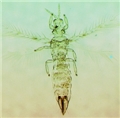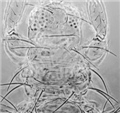Scolothrips sexmaculatus
Recognition data
Distinguishing features
Both sexes fully winged. Body yellow with grey markings laterally on pronotum, metascutellum, and abdominal tergites; pronotal setae dark; antennal segments III � VIII grey; forewings pale with dark clavus and two small transverse bands. Head wider than long; ocellar triangle without sculpture; three pairs of ocellar setae present, pair III very long and arising on anterior margins of ocellar triangle; postocular setae small, pair I close together behind hind ocelli. Antennae 8-segmented; segments III � IV with long forked sensorium. Pronotum with six pairs of long setae. Metanotum with weak sculpture; median setae arising at anterior margin; no campaniform sensilla. Forewing first and second veins each with about five to seven long setae. Abdominal tergites with no sculpture medially; tergite VIII with no posteromarginal comb; tergite X with no median longitudinal split. Sternites without discal setae. Male smaller; sternites III � VIII with broadly transverse glandular area.
Variation
The name S. sexmaculatus is applied to individuals that have three dark markings across each forewing, whereas those that lack the distal dark marking are considered to represent other species. However, the available material suggests that these dark markings are small or absent in individuals that have developed at high temperatures. The current species taxonomy within this genus is possibly not satisfactory.
Related and similar species
About 20 species are listed worldwide in this Old World genus. Some of these are distinguished from each other on the basis of small differences in body color (zur Strassen, 2003). The significance of these color differences needs to be studied in populations reared under different conditions, including temperature, humidity and available prey.
Taxonomic data
Current valid name
Scolothrips sexmaculatus (Pergande)
Original name and synonyms
Thrips sexmaculatus Pergande, 1890: 539
Family placement
Thripidae, Thripinae
Common names
Six banded thrips
Biological data
Life history
Predatory on mites
Host plants
Collected from many different plants, particularly bean crops and fruit trees.
Tospoviruses vectored
None
Crop damage
None
Distribution data
Area of origin
Not clear.
Distribution
North America and Australia. Not included by zur Strassen (2003) in the fauna of Europe and the Mediterranean, but there remains a possibility of further synonyms to be recognized.




